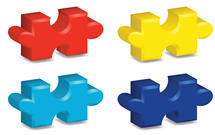 News that the Centers for Disease Control (CDC) updated its autism diagnosis estimate to 1 out of every 50 children drew the attention educators, parents of children with autism, and autism awareness advocates, all of whom say they hope schools can serve students on the autism spectrum, which includes a staggeringly wide range of student abilities and needs under its umbrella.
News that the Centers for Disease Control (CDC) updated its autism diagnosis estimate to 1 out of every 50 children drew the attention educators, parents of children with autism, and autism awareness advocates, all of whom say they hope schools can serve students on the autism spectrum, which includes a staggeringly wide range of student abilities and needs under its umbrella.
The new diagnosis numbers are “striking, especially when we put it into context,” said Nina Finkler, director of outreach for Eden Autism Services. This means that almost 750,000 individuals in the U.S. are diagnosed with autism spectrum disorder, and it is now the most frequently diagnosed childhood disorder, diagnosed more than cancer, diabetes, and other childhood illnesses combined.
Several factors contribute to autism’s increased prevalence, Finkler said. Twenty years ago, awareness surrounding autism spectrum disorder and what it meant was limited. Most children diagnosed with autism were previously thought to be hard or impossible to educate, and they often were placed in programs for children with emotional disturbances.
(Next page: How new definitions of autism spectrum disorder may impact schools)
“As awareness has grown, what we also see is a greater understanding of autism, both by parents and the medical profession, and considerable public and private dollars are spent to educate that first-line medical staff…to better screen and identify those children earlier so that we can start working with those children before they’re five years old,” Finkler said.
While not sufficient, an increase in autism funding, as well as increases in autism awareness and education, have led to more children receiving autism diagnoses, and at a younger age.
Finkler said that the number of children with “classic autism” has likely remained relatively steady, and that increased diagnoses estimates include many children with Asperger’s or pervasive developmental disorder not otherwise specified (PDD-NOS)—both of which fall under the autism umbrella.
With these increased diagnoses comes a bigger push for public school programs to effectively educate students with autism, whether they are able to remain in a general education classroom or require more specialized instruction.
A move to reclassify and redefine autism in the American Psychiatric Association’s (APA) Diagnostic and Statistical Manual of Mental Disorders (DSM) recommends “a new category called autism spectrum disorder which would incorporate several previously separate diagnoses, including autistic disorder, Asperger’s disorder, childhood disintegrative disorder and pervasive developmental disorder not otherwise specified,” according to an APA statement.
The DSM guides diagnoses all APA-recognized disorders, and the fifth version, set for release in mid-May 2013, would reduce the number of autism-related categories and pulls previously separate disorders, such as Asperger’s, under a more general autism spectrum disorder umbrella, which would be considered a global diagnosis with varying stages of severity, interventions, and support.
The DSM-5 also shows a significant change in diagnostic criteria, which is meant to better describe the areas of deficit that are associated with an autism diagnosis, Finkler said.
(Next page: The new DSM-5 guidelines)These new guidelines include:
1. Social communication and interaction
- Marked deficits in nonverbal and verbal social communication
- Lack of social reciprocity
- Failure to develop and maintain peer relationships
2. Restricted repetitive behavior, interests, and activities
- Stereotyped motor, verbal, and sensory behaviors
- Routines and rituals
- Restricted fixated interests
3. Symptoms are present in early childhood
In order to receive a diagnosis, a child must meet all the criteria in the first category, at least two in the second category, and the entire third category.
A diagnosis is the first step in securing services for a child with autism, Finkler said. Most education programs have 14 recognized education classifications, and depending on a child’s diagnosis, that child qualifies for special education services under one of those recognized educational classifications. Many states maintain a separate category for children with autism, much as they maintain a category for cognitive impairments or learning disabilities.
As the DSM-5 takes effect, “we need to look at the education departments of each state and see if their criteria for qualifying for services under the new diagnoses will be impacted,” Finkler said. Initially, when the APA released the proposed new criteria in 2012, parents worried that children who previously met the criteria might lose their special education eligibility, but several autism advocacy groups, including Autism Speaks and the Autism Society of America, conducted surveys and determined that most students who already have an autism classification would not lose their services.
One potentially problematic area is the elimination of the specific Asperger’s label. “That is an extremely active group—both the individuals and families. To not have that label any longer is going to have an interesting impact on this particular group,” Finkler said.
Follow Managing Editor Laura Devaney on Twitter @eSN_Laura.
- 4 components of an effective literacy ecosystem - October 22, 2024
- Students want more career-connected learning - October 18, 2024
- New E-rate rules could narrow the homework gap - October 17, 2024

